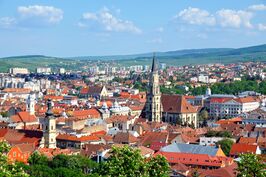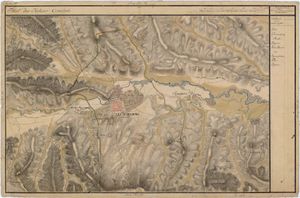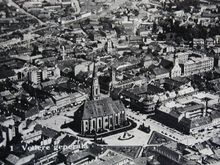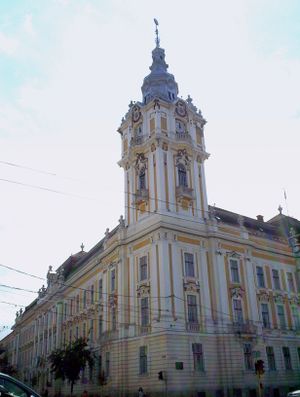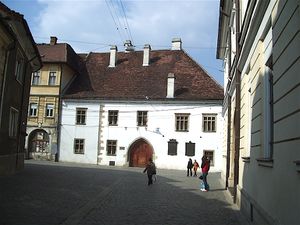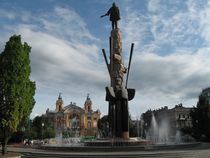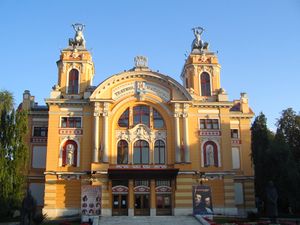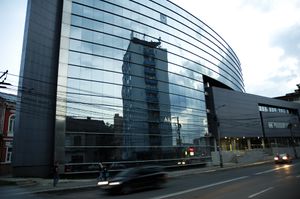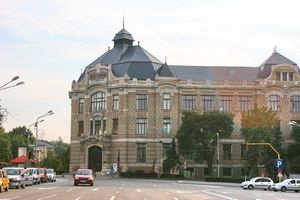كلوج-ناپوكا
كلوج-ناپوكا
Cluj-Napoca | |
|---|---|
From top and left: Cluj-Napoca panorama • Romanian National Opera • Tailors' Bastion • St. Michael's Church • Cluj Arena | |
| الكنية: | |
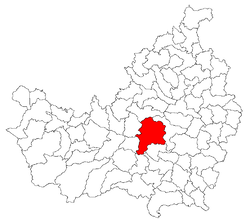 Location in Cluj County | |
| الإحداثيات: 46°46′N 23°35′E / 46.767°N 23.583°E | |
| Country | |
| Region | ترانسلڤانيا |
| المقاطعة | |
| Founded | 1213 (first official record as Clus) |
| الحكومة | |
| • العمدة (2020–2024) | Emil Boc[3] (PNL) |
| • Deputy Mayor | Dan Tarcea (PNL) |
| • Deputy Mayor | Emese Oláh (UDMR) |
| • City Manager | Gheorghe Șurubaru (PNL) |
| المساحة | |
| • مدينة ومقر مقاطعة | 179٫5 كم² (69٫3 ميل²) |
| • العمران | 1٬537٫5 كم² (593٫6 ميل²) |
| المنسوب | 340 m (1٬120 ft) |
| التعداد | |
| • مدينة ومقر مقاطعة | 324٬576 |
| • Estimate (2016)[6] | 321٬687 |
| • الكثافة | 1٬808/km2 (4٬680/sq mi) |
| • العمرانية | 411٬379[4] |
| منطقة التوقيت | UTC+2 (EET) |
| • الصيف (التوقيت الصيفي) | UTC+3 (EEST) |
| Postal Code | 400xyz1 |
| مفتاح الهاتف | +40 x642 |
| Car Plates | CJ-N3 |
| الموقع الإلكتروني | primariaclujnapoca |
| 1x, y, and z are digits that indicate the street, part of the street, or even the building of the address 2x is a digit indicating the operator: 2 for the former national operator, Romtelecom, and 3 for the other ground telephone networks 3used just on the plates of vehicles that operate only within the city limits (such as trolley buses, trams, utility vehicles, ATVs, etc.) | |
كلوج-ناپوكا (النطق بالرومانية: [ˈkluʒ naˈpoka] (![]() استمع); ألمانية: Klausenburg; مجرية: Kolozsvár, النطق في المجرية: [ˈkoloʒvaːr] (
استمع); ألمانية: Klausenburg; مجرية: Kolozsvár, النطق في المجرية: [ˈkoloʒvaːr] (![]() استمع); اللاتينية القروسطية: Castrum Clus, Claudiopolis; باليديشية: קלויזנבורג, Kloiznburg) تقع شمال-غرب رومانيا وهي عاصمة محافظة كلوج في إقليم ترانسلڤانيا وتعتبر من أهم عواصم التاريخية لهذا الإقليم.
تعتبر مركز إقتصادي وثقافي هام, بالإضافة كونها عقدة مواصلات مهمة في رومانيا. Geographically, it is roughly equidistant from Bucharest (445 كيلومتر (277 ميل)), Budapest (461 km (286 mi)) and Belgrade (483 km (300 mi)). Located in the Someșul Mic river valley, the city is considered the unofficial capital to the historical province of Transylvania. From 1790 to 1848 and from 1861 to 1867, it was the official capital of the Grand Principality of Transylvania.
استمع); اللاتينية القروسطية: Castrum Clus, Claudiopolis; باليديشية: קלויזנבורג, Kloiznburg) تقع شمال-غرب رومانيا وهي عاصمة محافظة كلوج في إقليم ترانسلڤانيا وتعتبر من أهم عواصم التاريخية لهذا الإقليم.
تعتبر مركز إقتصادي وثقافي هام, بالإضافة كونها عقدة مواصلات مهمة في رومانيا. Geographically, it is roughly equidistant from Bucharest (445 كيلومتر (277 ميل)), Budapest (461 km (286 mi)) and Belgrade (483 km (300 mi)). Located in the Someșul Mic river valley, the city is considered the unofficial capital to the historical province of Transylvania. From 1790 to 1848 and from 1861 to 1867, it was the official capital of the Grand Principality of Transylvania.
اعتبارا من 2011[تحديث], 324,576 inhabitants lived within the city limits (making it the country's second most populous at the time, after the national capital Bucharest), marking a slight increase from the figure recorded at the 2002 census.[5][7] The Cluj-Napoca metropolitan area has a population of 411,379 people,[4][8] while the population of the peri-urban area (Romanian: zona periurbană) exceeds 420,000 residents.[4][9] The new metropolitan government of Cluj-Napoca became operational in December 2008.[10] According to a 2007 estimate provided by the County Population Register Service, the city hosts a visible population of students and other non-residents—an average of over 20,000 people each year during 2004–2007.[11] The city spreads out from St. Michael's Church in Unirii Square, built in the 14th century and named after the Archangel Michael, the patron saint of Cluj-Napoca.[12] The boundaries of the municipality contain an area of 179.52 متر كيلومربع (69.31 sq mi).
Cluj-Napoca experienced a decade of decline during the 1990s, its international reputation suffering from the policies of its mayor at the time, Gheorghe Funar.[13] Today, the city is one of the most important academic, cultural, industrial and business centres in Romania. Among other institutions, it hosts the country's largest university, Babeș-Bolyai University, with its botanical garden; nationally renowned cultural institutions; as well as the largest Romanian-owned commercial bank.[14][15] Cluj-Napoca held the titles of European Youth Capital in 2015,[16] and European City of Sport in 2018.[17]
التسمية
كانت تسمى بالرومانية كلوج فقط حتى عام 1970 حيث أضيفت تسمية نابوكا .
عدد السكان
في 2008 كان عدد سكانها 309,300 نسمة حيث هي في المرتبة الثالثة بعد بوخارست و تيميشوارا, يذكر أن حوالي 60.000 من الهنغار يعيشون في هذه المدينة.
التاريخ
الامبراطورية الرومانية
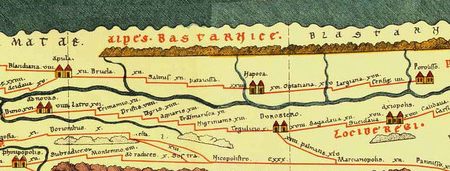
العصور الوسطى

القرن العشرون
الجغرافيا
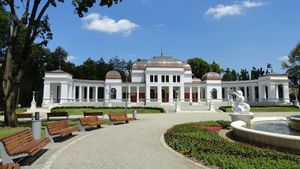


Surroundings
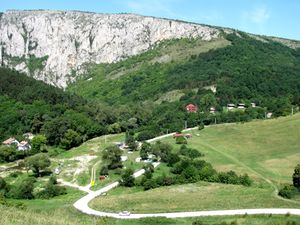


المناخ
| بيانات المناخ لـ كلوج-ناپوكا | |||||||||||||
|---|---|---|---|---|---|---|---|---|---|---|---|---|---|
| الشهر | ينا | فب | مار | أبر | ماي | يون | يول | أغس | سبت | أكت | نوف | ديس | السنة |
| القصوى القياسية °س (°ف) | 14.0 (57.2) |
19.3 (66.7) |
26.6 (79.9) |
30.2 (86.4) |
32.5 (90.5) |
36.0 (96.8) |
37.0 (98.6) |
38.0 (100.4) |
33.7 (92.7) |
32.6 (90.7) |
26.0 (78.8) |
18.7 (65.7) |
38.0 (100.4) |
| متوسط القصوى اليومية °س (°ف) | 0.3 (32.5) |
3.2 (37.8) |
9.9 (49.8) |
15.0 (59.0) |
20.3 (68.5) |
22.6 (72.7) |
24.5 (76.1) |
24.3 (75.7) |
20.7 (69.3) |
14.6 (58.3) |
6.3 (43.3) |
1.8 (35.2) |
13.6 (56.5) |
| المتوسط اليومي °س (°ف) | −3.4 (25.9) |
−1.2 (29.8) |
4.1 (39.4) |
9.0 (48.2) |
14.2 (57.6) |
16.6 (61.9) |
18.2 (64.8) |
17.8 (64.0) |
14.1 (57.4) |
8.5 (47.3) |
2.4 (36.3) |
−1.5 (29.3) |
8.2 (46.8) |
| متوسط الدنيا اليومية °س (°ف) | −6.5 (20.3) |
−4.7 (23.5) |
−0.6 (30.9) |
3.9 (39.0) |
8.6 (47.5) |
11.3 (52.3) |
12.7 (54.9) |
12.2 (54.0) |
8.9 (48.0) |
3.8 (38.8) |
−0.7 (30.7) |
−4.2 (24.4) |
3.7 (38.7) |
| الصغرى القياسية °س (°ف) | −34.2 (−29.6) |
−32.5 (−26.5) |
−22.0 (−7.6) |
−8.4 (16.9) |
−3.5 (25.7) |
0.4 (32.7) |
5.2 (41.4) |
3.5 (38.3) |
−3.0 (26.6) |
−8.8 (16.2) |
−22.3 (−8.1) |
−27.9 (−18.2) |
−34.2 (−29.6) |
| متوسط تساقط الأمطار mm (inches) | 24 (0.9) |
20 (0.8) |
22 (0.9) |
48 (1.9) |
69 (2.7) |
95 (3.7) |
81 (3.2) |
60 (2.4) |
36 (1.4) |
31 (1.2) |
30 (1.2) |
32 (1.3) |
548 (21.6) |
| متوسط هطول الثلج cm (inches) | 6.0 (2.4) |
11.5 (4.5) |
5.8 (2.3) |
1.3 (0.5) |
0.0 (0.0) |
0.0 (0.0) |
0.0 (0.0) |
0.0 (0.0) |
0.0 (0.0) |
0.5 (0.2) |
2.6 (1.0) |
5.8 (2.3) |
33.5 (13.2) |
| Average precipitation days (≥ 1.0 mm) | 6 | 5 | 5 | 9 | 11 | 11 | 10 | 8 | 6 | 6 | 7 | 7 | 91 |
| Mean monthly ساعات سطوع الشمس | 70.9 | 98.8 | 165.2 | 174.7 | 230.8 | 238.6 | 273.8 | 261.6 | 204.8 | 166.2 | 74.9 | 54.7 | 2٬015 |
| Source 1: NOAA[19] | |||||||||||||
| Source 2: Romanian National Statistic Institute (extremes 1901–2000)[20] | |||||||||||||
القانون والحكم
الادارة

| Party | Seats | Current Council | ||||||||||||
|---|---|---|---|---|---|---|---|---|---|---|---|---|---|---|
| Social Liberal Union | 12 | |||||||||||||
| Democratic Liberal Party | 10 | |||||||||||||
| Democratic Union of Hungarians in Romania | 4 | |||||||||||||
| People's Party – Dan Diaconescu | 1 | |||||||||||||
Demographics
| Historical population of Cluj-Napoca | |||||||||||||
| Year | Population | %± | Romanians | Hungarians | |||||||||
|---|---|---|---|---|---|---|---|---|---|---|---|---|---|
| 1453 est. | 6,000[21] | — | n/a | n/a | |||||||||
| 1703 | 7,500[22] | 25% | n/a | n/a | |||||||||
| 1714 | 5,000[23] | −33.3% | n/a | n/a | |||||||||
| 1770 | 10,500[24] | 110% | n/a | n/a | |||||||||
| 1785 | 9,703[22][25] | −7.6% | n/a | n/a | |||||||||
| 1787 | 10,476[22][25] | 7.9% | n/a | n/a | |||||||||
| 1835 | 14,000[22][26] | 33.6% | n/a | n/a | |||||||||
| 1850 | 19,612 | 40% | 21.0% | 62.8% | |||||||||
| 1880 | 32,831 | 67.4% | 17.1% | 72.1% | |||||||||
| 1890 | 37,184 | 13.2% | 15.2% | 79.1% | |||||||||
| 1900 | 50,908 | 36.9% | 14.1% | 81.1% | |||||||||
| 1910 census[b] | 62,733 | 23.2% | 14.2% | 81.6% | |||||||||
| 1920 | 85,509 | 36.3% | 34.7% | 49.3% | |||||||||
| 1930 census | 100,844[27] | 17.9% | 34.6% | 47.3% | |||||||||
| 1941[c][d] | 114,984 | 14% | 9.8% | 85.7% | |||||||||
| 1948 census | 117,915 | 2.5% | 40% | 57% | |||||||||
| 1956 census[e] | 154,723 | 31.2% | 47.8% | 47.9% | |||||||||
| 1966 census | 185,663 | 20% | 56.5% | 41.4% | |||||||||
| 1977 census | 262,858 | 41.5% | 65.8% | 32.8% | |||||||||
| 1992 census | 328,602 | 25% | 76.6% | 22.7% | |||||||||
| 2002 census | 317,953[7] | −3.2% | 79.4% | 19.0% | |||||||||
| 2011 census[f] | 324,576[5][4][28] | 2.1% | 81.5% | 16.4% | |||||||||
|
Source (if not otherwise specified): | |||||||||||||
الجالية المجرية
Economy

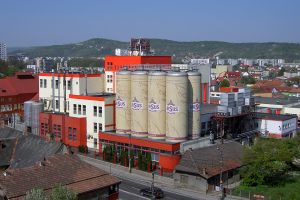

الفنون والثقافة
الفنون البصرية
الفنون الأدائية
العمارة المعاصرة
الإعلام والثقافة الشعبية
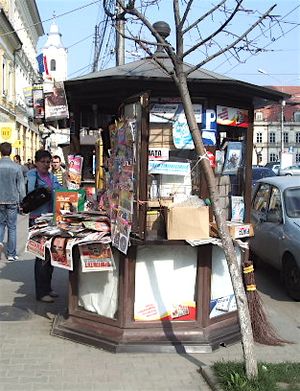
التعليم
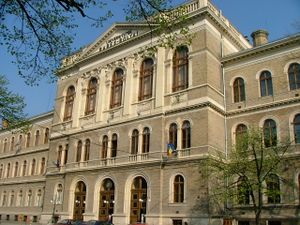
العلاقات الدولية
البلدات التوأم – المدن الشقيقة
Cluj-Napoca is twinned with:[30]
|
Footnotes
a.^ The engraving, dating back to 1617, was executed by Georg Houfnagel after the painting of Egidius van der Rye (the original was done in the workshop of Braun and Hagenberg).
b.^ After Transylvania united with Romania in 1918–1920, an exodus of Hungarian inhabitants occurred. Also, the city grew and many people moved in from the surrounding area and Cluj County as a whole, populated largely by Romanians.
c.^ In August 1940, as the second Vienna Award transferred the northern half of Transylvania to Hungary, an exile of Romanian inhabitants began.
d.^ The 1941 Hungarian census is considered unreliable by most historians. In 1941, Cluj had 16,763 Jews. They were forced into ghettos in 1944 by the Hungarian authorities and deported to Auschwitz in May–June 1944.
e.^ In the 1960s a determined policy of industrialisation was initiated. Many people from the surrounding rural areas (largely Romanian) moved into the city, giving Cluj a Romanian majority.
f.^ Data refer to those for whom ethnicity is available, and do not include the 23,165 individuals (7.1% of the city's population) for whom such data are unavailable.
انظر أيضاً
الهامش
- ^ "Portretul unui oraș" (in الرومانية). Clujeanul. 21 September 2007. Archived from the original on 24 August 2010. Retrieved 2008-10-09.
- ^ "A kincses város" (in الهنغارية). UFI. December 2004. Archived from the original on 2 September 2008. Retrieved 2008-10-09.
- ^ "Results of the 2020 local elections". Central Electoral Bureau. Retrieved 11 يونيو 2021.
- ^ أ ب ت ث "Rezultate definitive ale Recensământului Populației și Locuințelor – 2011 – analiza". Cluj County Regional Statistics Directorate. 5 July 2013. Retrieved 2013-07-05.[dead link] خطأ استشهاد: وسم
<ref>غير صالح؛ الاسم "INSSE-Cluj-2011-analiza" معرف أكثر من مرة بمحتويات مختلفة. - ^ أ ب ت "Comunicat de presă privind rezultatele finale ale Recensământului Populației și Locuințelor – 2011". Cluj County Regional Statistics Directorate. 5 July 2013. Retrieved 2013-07-05.[dead link] خطأ استشهاد: وسم
<ref>غير صالح؛ الاسم "INSSE-Cluj-2011" معرف أكثر من مرة بمحتويات مختلفة. - ^ "Populaţia României pe localitati la 1 ianuarie 2016" (in الرومانية). INSSE. 6 June 2016. Archived from the original on 27 October 2017. Retrieved 27 October 2017.
- ^ أ ب "Municipiul Cluj-Napoca (data based on the 2002 census)" (in الرومانية). Fundația Jakabffy Elemér. Archived from the original on 7 March 2008. Retrieved 2008-03-12.
- ^ "Zona Metropolitana Urbana" (in الرومانية). CJ Cluj. Retrieved 25 May 2009.
- ^ "Zona Metropolitană Urbană și Strategii de Dezvoltare a Zonei Metropolitane Cluj-Napoca" (in الرومانية). Cluj County Council. Retrieved 2008-03-12.
- ^ "Asociația Metropolitană e "la cheie". Mai trebuie banii" (in الرومانية). Ziua de Cluj. 9 January 2009. Archived from the original on 9 December 2012. Retrieved 2009-02-11.
- ^ "Wanted: clujeanul verde" (in الرومانية). Foaia Transilvană. 6 March 2008. Archived from the original on 11 May 2008. Retrieved 2008-05-12.
- ^ "Catedrala "Sf. Mihail"" (in الرومانية). Clujonline.com. Retrieved 2008-03-12.
- ^ "Cluj: Buzz grips university town". Financial Times. 6 March 2008. Retrieved 2008-03-13.
- ^ "Five alive – New regions – Five territories to watch". Monocle. Vol. 1, no. 9. December 2007. Archived from the original on 2008-03-05. Retrieved 2008-03-12.
- ^ Alexandra Groza (8 January 2008). "Presa britanică: "Clujul, campion mondial la dezvoltare"" (in الرومانية). Clujeanul. Archived from the original on 4 May 2008. Retrieved 2008-03-12.
- ^ "cluj2015.eu". www.cluj2015.eu.
- ^ Raluca Sas (6 December 2017). "Cluj-Napoca a câștigat titlul de "Oraș European al Sportului 2018"". monitorulcj.ro (in الرومانية).
- ^ Bunbury 1879, p. 516.
- ^ "Cluj Climate Normals 1961–1990". National Oceanic and Atmospheric Administration. Retrieved 21 March 2015.
- ^ "Air Temperature (monthly and yearly absolute maximum and absolute minimum)" (PDF). Romanian Statistical Yearbook: Geography, Meteorology, and Environment. Romanian National Statistic Institute. 2007. Retrieved 27 November 2012.
- ^ Pascu 1974, p.102
- ^ أ ب ت ث Pascu 1974, pp.222–3
- ^ Pascu et al. 1957, p.60
- ^ Trócsányi, Zsolt. "History of Transylvania". Institute of History of the Hungarian Academy of Sciences.
- ^ أ ب Jakab Elek, Kolozsvar Tortenete, II, Okleveltar, Budapesta, 1888, p.750
- ^ Katona Lajos, Kolozsvar terulete es nepessege, in "Kolozsvari Szemle", 1943, no.4, p.294
- ^ Brubaker, Rogers (24 September 2008). "Nationalist Politics and Everyday Ethnicity in a Transylvanian Town" (PDF). National Program Excellent University. Retrieved 2011-04-09.
- ^ "Populația stabilă după etnie – județe, municipii, orașe, comune". National Institute of Statistics. 5 July 2013. Retrieved 2013-07-22.
- ^ خطأ استشهاد: وسم
<ref>غير صحيح؛ لا نص تم توفيره للمراجع المسماةvarga-arpad - ^ "Orașe infrățite". Cluj-Napoca City Hall. Retrieved 2015-01-16.
- ^ "Pesquisa de Legislação Municipal – No 14471". Prefeitura da Cidade de São Paulo [Municipality of the City of São Paulo] (in Portuguese). Archived from the original on 18 October 2011. Retrieved 2013-08-23.
{{cite web}}: Unknown parameter|trans_title=ignored (|trans-title=suggested) (help)CS1 maint: unrecognized language (link) - ^ Lei Municipal de São Paulo 14471 de 2007 WikiSource (البرتغالية)
- ^ Marius Mureșan (13 January 2009). "Municipiul Cluj-Napoca s-a înfrățit cu orașul Valdivia, din Chile" (in Romanian). Napoca News. Retrieved 2012-06-28.
{{cite web}}: CS1 maint: unrecognized language (link)
المراجع
- Gh. Lazarovici, D. Alicu, C. Pop, I. Hica, P. Iambor, Șt. Matei, E. Glodaru, I. Ciupea, Gh. Bodea (1997). Cluj-Napoca – Inima Transilvaniei. Cluj-Napoca: Editura Studia. ISBN 973-97555-0-X.
{{cite book}}: CS1 maint: multiple names: authors list (link) - Gheorghe Bodea (2002). Clujul vechi și nou. Cluj-Napoca: ProfImage. ISBN 973-0-02539-8.
- Rogers Brubaker, Margit Feischmidt, Jon Fox & Liana Grancea (2006). "Introduction". Nationalist Politics and Everyday Ethnicity in a Transylvanian Town. Princeton, New Jersey: Princeton University Press. ISBN 0-691-12834-0.
{{cite book}}: External link in|chapterurl=|chapterurl=ignored (|chapter-url=suggested) (help)CS1 maint: multiple names: authors list (link) - Bunbury, Edward Herbert (1879). A History of Ancient Geography among the Greeks and Romans. London: John Murray, Albemarle Street.
{{cite book}}: Invalid|ref=harv(help) - Lukács József (2005). Povestea orașului-comoară. Scurtă istorie a Clujului și monumentelor sale. Cluj-Napoca: Apostrof. ISBN 973-9279-74-0.
- Raoul Șorban (2003). Invazie de stafii. Însemnări și mărturisiri despre o altă parte a vieții. Bucharest: Meridiane. ISBN 973-33-0477-8.
- Dorin Alicu (2003). Județul Cluj – trecut și prezent. Cluj-Napoca: ProfImage. ISBN 973-555-090-3.
- Dorin Alicu, Ion Ciupea, Mihai Cojocneanu, Eugenia Glodariu, Ioana Hica, Petre Iambor, Gheorghe Lazărov (1995). Cluj-Napoca, de la începuturi până azi. Cluj-Napoca: Clusium. ISBN 973-7924-05-3.
{{cite book}}: CS1 maint: multiple names: authors list (link) - Cluj-Napoca=Claudiopolis. Bucharest: Noi Media Print. 2004.
- Cluj-Napoca – Ghid. Sedona. 2002.
- Ștefan Pascu, Iosif Pataki, Vasile Popa (1957). Clujul.
{{cite book}}: CS1 maint: multiple names: authors list (link) - Ștefan Pascu, Viorica Marica (1969). Clujul medieval. Bucharest: Meridiane.
- Ștefan Pascu (1974). Istoria Clujului. Bucharest.
{{cite book}}: CS1 maint: location missing publisher (link) - Aurel Anton, Iuliua Cosma, Vasile Popa, Gheorghe Voișanu (1973). Cluj. Ghid turistic al județului. Bucharest: Editura pentru Turism.
{{cite book}}: CS1 maint: multiple names: authors list (link) - Simon András, Gáll Enikõ, Tonk Sandor, Laszlo Tamas, Maxim Aurelian, Jancsik Peter, Coroiu Teodora (2003). Atlasul localităților județului Cluj. Cluj-Napoca: Suncart.
{{cite book}}: CS1 maint: multiple names: authors list (link) - "Cluj-Napoca, orașul comoară al Transilvaniei, România". CLUJonline.com. Retrieved 2007-03-11.
- "O istorie inedită a Clujului". ReMARK ltd. Archived from the original on 3 February 2007. Retrieved 2007-03-11.
- "Anuarul Institutului de Istorie "George Bariț" din Cluj-Napoca". "George Bariț" History Institute, Cluj-Napoca / Romanian Academy. Retrieved 2007-03-11.
وصلات خارجية
Official websites
- Cluj-Napoca: Official administration site (Romanian)
- Cluj County Prefecture (Romanian)
- Cluj-Napoca Local Civic Council (Romanian)
- CTP (Public Transport Company) official website (Romanian)
- Cluj-Napoca International Airport (إنگليزية) (Romanian)
City guides
- Interactive map, directory and various connected to the city (إنگليزية) (Romanian) (مجرية) (بالعربية) (بالألمانية) (بالإسپانية) {{{1}}}, {{{2}}} (بالفرنسية) (Italian) (هولندية) (بالروسية) (لغة تركية)
- Road map of the access points to Cluj-Napoca
Photos
قالب:Cities in Cluj county قالب:PlacesCluj قالب:Companies in Cluj-Napoca
- CS1 الرومانية-language sources (ro)
- CS1 الهنغارية-language sources (hu)
- Articles with dead external links from July 2017
- CS1 errors: unsupported parameter
- Short description is different from Wikidata
- Articles containing رومانية-language text
- Pages using Lang-xx templates
- Articles containing مجرية-language text
- Pages using infobox settlement with possible nickname list
- Pages using gadget WikiMiniAtlas
- Articles containing ألمانية-language text
- Articles containing يديشية-language text
- مقالات فيها عبارات متقادمة منذ 2011
- جميع المقالات التي فيها عبارات متقادمة
- Articles with hatnote templates targeting a nonexistent page
- CS1 maint: location missing publisher
- Articles with Hungarian-language external links
- كلوج-ناپوكا
- Populated places in Cluj County
- Capitals of the Principality of Transylvania
- مدن رومانيا
